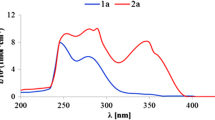Abstract
A series of mono and disubstituted 2,3-dihydroquinazolin-4(1H)-ones (DHQZs) were synthesized and the electronic and steric effects of the C2- and N3-substitutions on the retention or elimination of the C2-substitution by exposing them to the ultraviolet light were investigated. Electron transfer from photo-excited dihydroquinazolinones to chloroform solvent is proposed, in which both lone pairs on the N1- and N3-atoms can be involved in this process. The extent of the N1- and N3-atoms contributions in this electron-transfer process and also the retention or elimination of the C2-substitutions are dependent on the nature and steric hindrance of both C2- and N3-substitutions. The experimental results are supported by the computational studies.
Graphic abstract
Photoinduced electron-transfer reaction of a series of mono and disubstituted 2,3- dihydroquinazolin-4(1H)-ones was investigated.




Similar content being viewed by others
References
Vijaychand A, Manjula SN, Bharath EN, Divya B (2011) Medicinal and biological significance of quinazoline a highly important scaffold for drug discovery: a review. Int J Pharma Bio Sci 2:780–809
Mahato AK, Srivastava B, Nithya S (2011) Chemistry structure activity relationship and biological activity of quinazoline-4 (3H)-one derivatives. Med Chem 2:1–6
Badalato M, Aiello F, Neamati N (2018) 2,3-Dihydroquinazolin-4(1H)-one as a privileged scaffold in drug design. RSC Adv 8:20894–20921. https://doi.org/10.1039/c8ra02827c
Asif M (2014) Chemical characteristics, synthetic methods, and biological potential of quinazoline and quinazolinone derivatives. Int J Med Chem. https://doi.org/10.1155/2014/395637
Abdalgane HA, Mohammed HH, Askar FW (2019) Synthesis and biological evaluation studies of some quinazolinone derivatives as antimicrobial and antioxidant agents. J Pharm Sci. Res 11:54–57
Abdel Gawad NM, Georgey HH, Youssef RM, El-Sayed NA (2010) Synthesis and antitumor activity of some 2,3-disubstituted quinazolin-4(3H)-ones and 4,6-disubstituted 1,2,3,4-tetrahydroquinazolin-2H-ones. Eur J Med Chem 45:6058–6067. https://doi.org/10.1016/j.ejmech.20
Wang J, Zhang M-M, Wang X-S (2017) Structurally diversified synthesis of 2,3-dihydroquinazolin-4-(1H)-ones from 2-aminobenzamides and 1,2-dicarbonyl compounds in ionic liquids catalyzed by iodine. Res Chem Intermed 43:2985–3005. https://doi.org/10.1007/s11164-016-2807-1
Zhang Z-H, Lü H-Y, Yang S-H, Gao J-W (2010) Synthesis of 2,3-dihydroquinazolin-4(1H)-ones by three-component coupling of isatoic anhydride, amines, and aldehydes catalysed by magnetic Fe3O4 nanoparticles in water. J Comb Chem 12:643–646. https://doi.org/10.1021/cc100047j
Sharma M, Pandey S, Chauhan K, Sharma D, Kumar B, Chauhan PM (2012) Cyanuric chloride catalyzed mild protocol for synthesis of biologically active dihydro/spiro quinazolinones and quinazolinone-glycoconjugates. J Org Chem 77:929–937. https://doi.org/10.1021/jo2020856
Takacs A, Fodor A, Nemeth J, Hell Z (2014) Zeolite-catalyzed method for the preparation of 2,3-dihydroquiazolin-4(1H0-ones. Synth Commun 44:2269–2275. https://doi.org/10.1080/00397911.2014.894525
Krishnan S, Ganguly S, Veerasamy R, Jan B (2011) Synthesis, antiviral and cytotoxic investigation of 2-phenyl-3-substituted vquinazolin-4(3H)-ones. Eur Rev Med Pharmacol Sci 15:673–681
Georgey H, Abdel-Gawad N, Abbas S (2008) Synthesis and anticonvulsant activity of some quinazolin-4-(3H)-one derivatives. Molecules 13:2557–2569. https://doi.org/10.3390/molecules13102557
Ding MW, Zeng GP, Wu TJ (2000) A facile synthesis of 2-mino-3H-quinazolin-4-ones with tandem aza-Wittig reaction. Synth Commun 30:1599–1604. https://doi.org/10.1080/00397910008087195
Panneerselvam P, Ahmad BR, Reddy DRS, Kumar NR (2009) Synthesis and anti-microbial screening of some Schiff bases of 3-amino-6,8-dibromo-2-phenylquinazolin-4(3H)-ones. Eur J Med Chem 44:2328–2333. https://doi.org/10.1016/j.ejmech.2008.04.010
Ghosh SK, Nagarajan R (2016) Total synthesis of penipanoid C, 2-(4-hydroxybenzyl)quinazolin4(3H)-one and NU1025. Tetrahedron Lett 57:4277–4279. https://doi.org/10.1016/j.tetlet.2016.08.018
Peng Y-Y, Zeng Y, Qiu G, Cai L, Pike VW (2010) A convenient one-pot procedure for the synthesis of 2-arylquinazolines using active MnO2 as oxidant. J Heterocyclic Chem 47:1240–1245. https://doi.org/10.1002/jhet.444
Cabrera-Rivera FA, Ortíz-Nava C, Escalante J, Hernández-Pérez JM, Hô M (2012) Pothotoinduced elimination in 2,3-dihydro-2-tert-butyl-3-benzyl-4(1H)-quinazolinone: theoretical calculations and radical trapping using TEMPO derivatives. Synlett 23:1057–1063. https://doi.org/10.1055/s-0031-1290492
Memarian HR, Kalantari M (2017) Steric and electronic substitution effects on the thermal oxidation of 5-carboethoxy-2-oxo-1,2,3,4-tetrahydropyridines. J Iran Chem Soc 14:143-155 and references cited therein. https://doi.org/10.1007/s13738-016-0966-z
Memarian HR, Minakar R (2019) Thermal electron-transfer induced oxidation of 2-pyrazolines. Mol Div 23:953–964. https://doi.org/10.1007/s11030-019-09922-x
Memarian HR, Sanchooli E (2017) Photo-dehydrogenation of 4,6-diaryl-2-oxo-1,2,3,4-tetrahydropyrimidines. J Iran Chem Soc 14:1335-1346 and references cited therein. https://doi.org/10.1007/s13738-017-1084-2
Soltani M, Memarian HR, Sabzyan H (2018) Spectroscopic studies of aryl substituted 1-phenyl-2-pyrazolines: steric and electronic substitution effects. J Mol Struc 1173:903-917 and references cited therein. https://doi.org/10.1016/j.molstruc.2018.07.052
Soltani M, Minakar R, Memarian HR, Sabzyan H (2019) Cyclic voltammetric study of 3,5-diaryl-1-phenyl-2-pyrazolines. J Phys Chem C 123:2820-2830 and references cited therein. https://doi.org/10.1021/acs.jpca.9b00642
Memarian HR, Kalantari M, Amiri Rudbari H, Sabzyan H, Bruno G (2017) DFT and structural studies of 2-oxo-1,2,3,4-tetrahydropyridines. Comp Theo Chem 1099:75–86. https://doi.org/10.1016/j.comptc.2016.11.018
Memarian HR, Ebrahimi S (2013) Light induced oxidation of 2,3-dihydroquinazolin-4(1H)-ones. J Photochem Photobiol A: Chem. 271:8–15. https://doi.org/10.1016/j.photochem.2013.07.008
Memarian HR, Ghahremani S (2017) Electron transfer-induced oxidation of 2,3-dihydroqinazolin-4(1H)-ones. Z Naturforsch 72:403–408. https://doi.org/10.1007/s00706-014-1221-x
Memarian HR, Ebrahimi S (2014) Theoretical and voltammetric studies on the electron detachment process of 2,3-dihydroquinazolin-4(1H)-ones. Monatsh Chem 145:1545–1554. https://doi.org/10.1007/s00706-014-1221-x
Memarian HR, Ebrahimi S, Amiri Rudbari H, Sabzyan H, Nardo VM (2016) Inter- and interamolecular interactions in 2,3-dihydroquinazolin-4(1H)-ones: molecular structure and conformational analysis. J Iran Chem Soc 13:1395–1404. https://doi.org/10.1007/s13738-016-0854-6
Memarian HR, Soleymani M, Sabzyan H (2012) Light-induced dehydrogenation of 2-oxo-1,2,3,4-tetrahydropyrimidine-5-carboxamides. J Iran Chem Soc 9:805–813. https://doi.org/10.1007/s13738-012-0097-0
Soltani M, Memarian HR, Sabzyan H (2020) Photooxidation of 3,5-diaryl-1-phenyl-2-pyrazolines: experimental and computational studies. J Photochem Photobiol A: Chem 389:112285. https://doi.org/10.1016/j.photochem.2019.112285
Jin M-Z, Yang L, Wu L-M, Liu Y-C, Liu Z-L (1998) Novel photo-induced aromatization of Hantzsch 1,4-dihydropyridines. Chem Commun. https://doi.org/10.1039/a807093h
Chen L, Farahat MS, Gan H, Farid S, Whitten DG (1995) Photoinduced electron transfer double fragmentation: an oxygen-mediated radical chain process in the cofragmentation of aminopinacol donors with organic halides. J Am Chem Soc 117:6398–6399. https://doi.org/10.1021/ja00128a046
Acknowledgement
We are thankful to the Research Council and Office of Graduate Studies of the University of Isfahan for their financial support.
Author information
Authors and Affiliations
Corresponding author
Additional information
Publisher's Note
Springer Nature remains neutral with regard to jurisdictional claims in published maps and institutional affiliations.
In memory of Prof. Dr. Dietrich Dӧpp, Universität Duisburg, Germany, who passed away on September 25, 2019.
Electronic supplementary material
Below is the link to the electronic supplementary material.
Rights and permissions
About this article
Cite this article
Memarian, H.R., Aghalar, R. Photooxidation of 2,3-dihydroquinazolin-4(1H)-ones: retention or elimination of 2-substitution. Mol Divers 26, 191–203 (2022). https://doi.org/10.1007/s11030-020-10174-3
Received:
Accepted:
Published:
Issue Date:
DOI: https://doi.org/10.1007/s11030-020-10174-3



